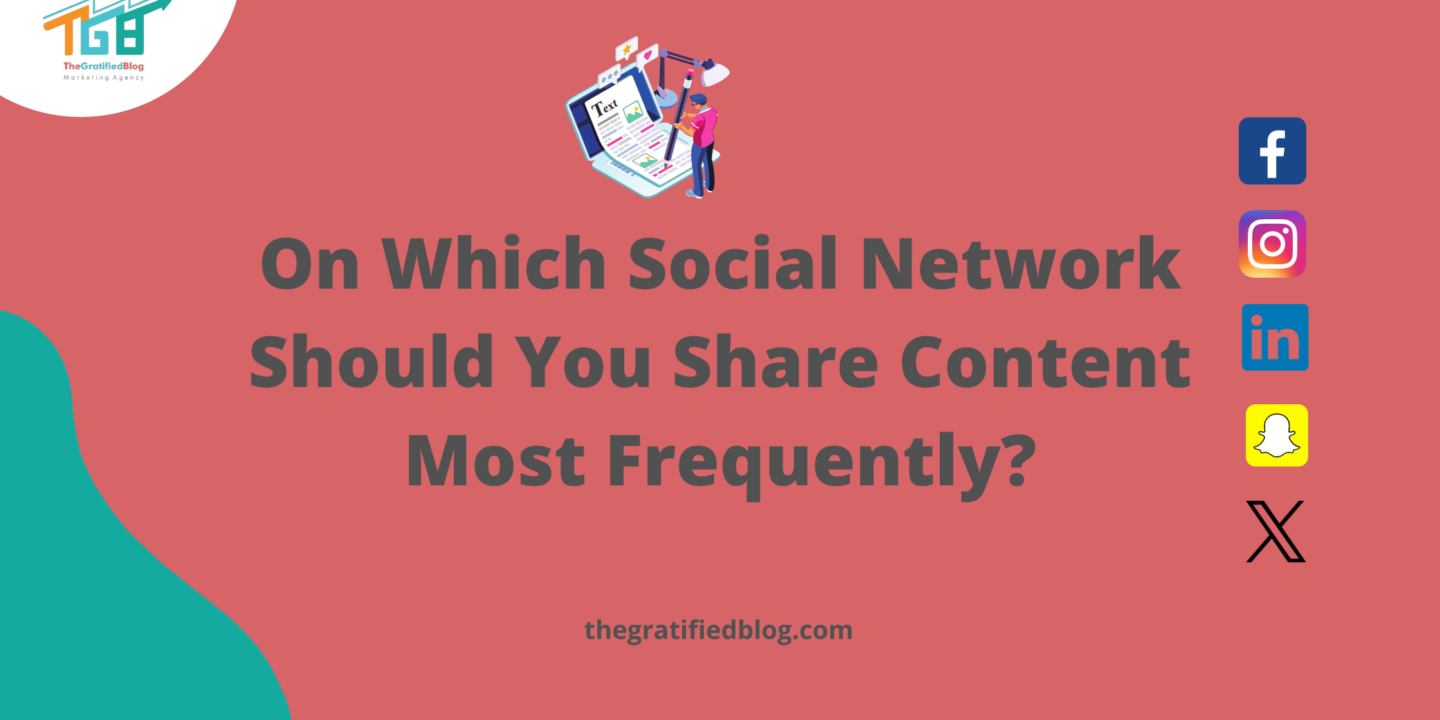
In the ever-evolving landscape of social media, where countless platforms compete for our attention, a critical question prevails: “On which social network should you share content most frequently?” Solving this question is crucial for unlocking the full potential of your digital presence. In a world of hashtags, likes, shares, and retweets, the right platform can be the difference between content that soars and content that falls by the wayside.
This blog post will comprehensively analyze “On Which Social Network Should You Share Content Most Frequently?” We will examine the significance of selecting the appropriate social media platform for frequent content sharing and why Twitter is often considered the prime choice. Additionally, we will scrutinize why other social media platforms hold different levels of importance in this context. Finally, we will arrive at our conclusions based on the insights provided.
Before answering the question, let’s understand the significance of selecting the appropriate social media platform.
The Importance Of Choosing The Right Social Network For Frequent Content Sharing
Selecting the right social media platform for sharing your content is incredibly important in today’s digital world. There are many different social media platforms, each used by a unique group of people who behave differently online. Picking the right platform is essential because it dramatically affects how effective your content marketing will be.
This section will examine why choosing the perfect platform is a big deal.
- Target Audience Relevance: Different social media platforms attract distinct user demographics. For instance, Instagram is popular among younger audiences, while LinkedIn caters more to professionals. You can guarantee that your message is delivered to the intended audience by aligning your content with the platform that resonates most with your target audience.
- Content Format Suitability: Each platform supports various content formats, such as text posts, images, videos, and live streams. Understanding which formats perform best on a particular platform is essential. For example, Instagram is image-centric, making it ideal for visual content, while Twitter’s character limit encourages concise text updates.
- Engagement Opportunities: Some social networks offer unique engagement features that can enhance your content’s reach and impact. For instance, Twitter’s retweeting and hashtag features can amplify your content’s visibility, while Facebook’s Groups allow you to build niche communities around your content.
- Algorithmic Considerations: Social media platforms employ algorithms to determine what content appears on users’ feeds. Understanding these algorithms and tailoring your content to align with them can significantly affect your content’s visibility and engagement. Some platforms prioritize recency, while others emphasize user interactions.
- Industry and Niche Relevance: Specific industries and niches have a more substantial presence on specific social networks. For example, fashion and beauty brands often thrive on Instagram, while B2B companies succeed on LinkedIn. Analyzing where your competitors and peers are active can inform your platform choice.
- Content Frequency Expectations: Different platforms have varying expectations regarding the frequency of content sharing. While Twitter encourages frequent updates, platforms like LinkedIn may favor less frequent but high-quality posts. Adhering to these expectations can help you maintain a consistent presence without overwhelming your audience.
- Analytical Insights: Social media platforms provide analytics tools that offer valuable insights into your content’s performance. Utilize these insights to assess your content strategy effectiveness and make data-driven decisions about which platforms deliver the best results.
Now that we’ve established the significance of selecting the appropriate social media platform for frequent content sharing, let’s address the question.
Let’s answer the inquiry:
On Which Social Network Should You Share Content Most Frequently?
- Snapchat
The answer is “Twitter.
Let’s explore “Twitter” in detail.
Why Is Twitter The Ideal Platform For Frequent Content Sharing?
Boasting 330 million monthly active users, Twitter is a versatile and influential content-sharing platform.
Here are several compelling reasons why Twitter should be your primary focus:
- Real-Time Engagement: Twitter thrives on real-time engagement. Its fast-paced nature allows you to share content instantly and engage with your audience in the moment. When breaking news, trending topics, or current events arise, Twitter is often the first platform people turn to for updates and discussions. By frequently sharing content on Twitter, you can tap into this immediacy and be part of ongoing conversations.
- Broad Reach: Twitter’s global reach ensures that your content can reach a vast and diverse audience. Unlike some other platforms with more localized user bases, Twitter connects you with people from all corners of the world. This diversity can be a significant advantage, especially if your content appeals to a broad audience or you want to expand your reach beyond your immediate geographic location.
- Hashtags For Discoverability: Utilizing hashtags strategically on Twitter, Including pertinent hashtags in your tweets, can markedly enhance the visibility of your content. Make it simpler for users interested in those subjects to come across your content. Additionally, using hashtags can help your content become part of trending topics, increasing the chances of more people seeing and engaging with it.
- Retweets And Virality: Twitter’s retweet feature allows users to easily share their content with their followers, amplifying its reach and potentially making it go viral. A well-crafted tweet can spread like wildfire, reaching a broad audience beyond your immediate followers. Frequent sharing on Twitter increases the chances of your content gaining traction and becoming widely shared.
- Engaged Audience: Twitter users are known for their active engagement and willingness to interact with content creators. Unlike other platforms where passive scrolling is more common, Twitter users often reply, comment, and engage in meaningful conversations. This level of engagement can lead to valuable connections and discussions around your content.
- Timely Updates And Announcements: For businesses and individuals looking to share timely updates, announcements, or promotions, Twitter is an ideal platform. Its real-time nature ensures that your audience receives the latest information promptly. Whether launching a new product, announcing an event, or sharing industry news, Twitter lets you get the word out quickly.
Now that we have uncovered the ideal answer to “On Which Social Network Should You Share Content Most Frequently?”—undeniably Twitter—it’s equally crucial to understand why other platforms may not hold as much significance regarding frequent content sharing. Let’s delve into the reasons behind these alternative platforms’ relative unimportance in content distribution and engagement.
Why Other Platforms Are Less Important For Frequent Content Sharing?
While Twitter undoubtedly presents numerous advantages regarding frequent content sharing, exploring why other social media platforms may be less pivotal for this specific purpose is equally important.
Let’s explore why:
Facebook, known for its enormous number of users, is a promising place to share content. But here’s the twist: Facebook has changed how it shows posts to people. Instead of showing everything in a straightforward timeline, it’s become picky. It prefers showing posts from your friends and family rather than from businesses or famous people. This means if you’re sharing content as a business or public figure, fewer people might see it. That’s because Facebook wants to keep its users’ feeds more personal, filled with updates from their loved ones.
If you share content frequently on Facebook, it might get less attention than you hope. The visibility and engagement could be lower compared to a platform like Twitter, where real-time discussions and sharing are more the norm. Facebook is more about personal connections, which is excellent for keeping up with friends but not always the best for seeing your content by a broad audience, especially if you’re a business or public figure.
Instagram is like a digital art gallery. People post pictures and short videos there, making it a fantastic place for telling visual stories. However, there’s a catch if you want to share content often. To succeed on Instagram, you must create beautiful pictures and videos. This means you must spend more time ensuring your visuals are top-notch. That can be time-consuming.
Also, Instagram doesn’t treat all posts equally. It tends to show the newest stuff first. So, if you post something and post more content, the older stuff gets pushed down, and fewer people see it. This can make it hard to keep your content in front of your followers consistently. It’s like trying to keep your art in the spotlight in a bustling gallery where new paintings often get more attention.
LinkedIn is like a digital space for professionals to meet and connect, like a big online networking event. It’s especially great if you’re in business and want to connect with other businesses. You can distribute content about your industry and engage with your audience in your field. But here’s the thing: LinkedIn is more relaxed than some other places, like Twitter. People share stuff there less often. They like to keep it more focused on serious topics, like work and career stuff.
LinkedIn might not be the best place if you want to share content a lot. People there don’t usually post as frequently as they do on Twitter, and they’re more into business and career discussions. If your content is more casual or not about business, it might not match the vibe of LinkedIn.
TikTok
TikTok is like a new kid on the social media block, famous for its super-short videos. It’s great if you love making fun and quick videos. But here’s the catch: TikTok is a bit different. It’s not like other places where you can just write a post or share a picture. You need to make these short, catchy videos, which can be challenging for everyone. It’s like being a mini-movie director. If you want to share content often, TikTok might not be the best choice because making those videos takes time and skill.
Plus, TikTok is all about videos. If your content doesn’t fit into a short video format, it might not work well there. It’s akin to attempting to insert a square peg into a round hole. So, while TikTok is fantastic, it’s only for some, and it is the best place for frequent content sharing if you’re good at making those snappy videos.
Snapchat
Snapchat is like a digital playground, especially loved by younger folks. It’s all about sending pictures and videos that disappear shortly. It’s like sharing something, and then it’s gone, just like magic. This makes it fun and exciting for quick exchanges with friends. But here’s the thing: because things vanish so fast on Snapchat, there are better places for sharing content often. If you want your stuff to stay around for a while or reach many people, Snapchat might not be the right choice.
Imagine you have a message on a sticky note that you want everyone to see. Snapchat is like showing that sticky note to a few friends for a moment, and then it’s gone. If you want your message to stick around and be seen by many more people, you’d need a different platform, like Twitter, where things stay visible for longer and have a broader reach. Snapchat is a blast for quick chats, but it could be better for frequent content sharing with a more extended impact.
Measuring The Significance Of Twitter With Analytics
Measuring the importance of Twitter for your social media strategy and content sharing involves analyzing various analytics and metrics. These metrics can provide insights into the reach, engagement, and impact of your content on Twitter. Here are some key analytics to measure the importance of Twitter:
- Follower Growth: Monitor the growth of your Twitter followers over time. A consistent growth in followers signifies that your content is gaining traction with the Twitter audience.
- Impressions: Impressions represent the total number of times your tweets were viewed. It’s a fundamental metric for understanding the reach of your content.
- Engagement Rate: Calculate the engagement rate by dividing the total engagements (likes, retweets, replies) by the total impressions. This metric reveals how well your content engages your audience.
- Click-Through Rate (CTR): If you share links in your tweets, track the CTR to measure how many users click on the links. It’s a valuable metric for assessing the effectiveness of your content in driving website traffic.
- Retweets and Shares: The number of times your tweets are retweeted or shared is a vital indication of the caliber and pertinence of your content. It also extends the reach of your tweets.
FAQs
Q1. Why is choosing a social network so important for frequent content sharing?
A. The choice of social network matters because each platform possesses its distinctive audience, characteristics, and functionalities. Choosing the appropriate one can have a substantial effect on the outcome.
Q2. Is it necessary to share content frequently on social media?
A. Frequent content sharing can be beneficial, but it depends on your goals and audience. For some, a consistent schedule may work better than frequent sharing. It’s essential to strike the right balance.
Q3. Why is Twitter often recommended for frequent content sharing?
A. Twitter is favored for its real-time engagement, broad reach, and hashtag usage. Its fast-paced nature makes it ideal for frequent updates and discussions, ensuring your content reaches a wide audience.
Conclusion
Now that we know On Which Social Network Should You Share Content Most Frequently? Then why not use the power of the particular platform? Utilize it today and see what it can do for your business.If you still have any questions related to the blog, then feel free to leave your questions in the comments section. We will be happy to answer you.
Thanks for reading 🙂








No Comments